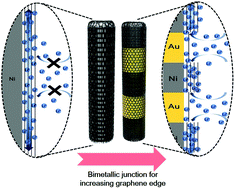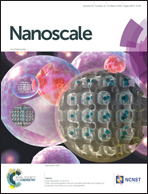Bimetallic junction mediated synthesis of multilayer graphene edges towards ultrahigh capacity for lithium ion batteries†
Abstract
In this work, we report on a novel strategy to synthesize high-density graphene edges on a vertically-aligned nanorod array substrate based on multiple segmented Ni–Au units. The growth of graphene layers on Ni and Au was performed by chemical vapor deposition (CVD) leading to the effective generation of edge-rich multilayer graphene due to the distinct carbon solubility. The composite material was applied as an anode in a lithium ion battery (LIB) whose discharging capacity was found to closely depend on the total number of Ni–Au junctions within the vertical nanorods. Graphene deposited on the 19-junction composite Ni–(Au–Ni)9 exhibited an ultrahigh capacity of 86.3 μAh cm−2 at 50 μA cm−2 which was much higher than graphene deposited on 1-junction, 2-junction and pure Ni nanorods. This ultrahigh capacity was mainly ascribed to the generation of high-density graphene edges engineered by the bimetallic junction. The proposed strategy opens new appealing routes to synthesize high-density graphene edges using bimetallic junctions, which is promising for increasing the performance of LIBs and other electrochemical energy systems (supercapacitors, fuel cells, etc.).



 Please wait while we load your content...
Please wait while we load your content...